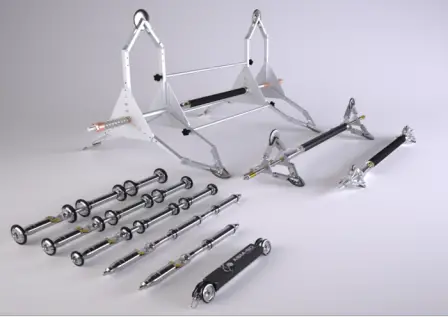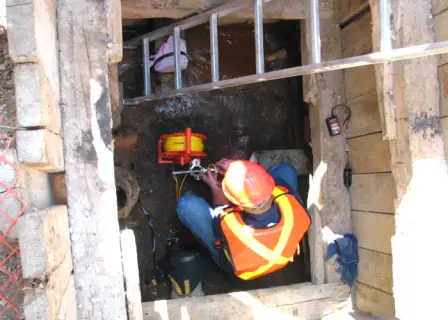Over the last two decades, significant advances have been made in the quality and application of inertial navigation technology targeted at mapping underground pipe and duct assets.
Reduct is a pioneer and world leader in the development of purpose-built sub-surface pipeline mapping systems. Reduct’s Ductrunner mapping solutions can map pipes and ducts with a minimum Internal Diameter (ID) of 30mm/1.25”, regardless of material, or type of utility. Because all devices record data autonomously, it is not necessary to trace from above, entry and exit coordinate will suffice.
Inertial navigation technology can provide solutions on several levels. Utility owners may prescribe it to obtain accurate as-built data of existing and new built for their GIS platform. Likewise, Utility owners can use it as a due diligence tool to verify as-built accuracy of pipes and duct they acquire from third parties. Contractors, on the other hand, can use it to reduce installation risk by verifying the shape of an existing data duct prior to pulling in a power or data cable.

Background
Location! That’s the primary concern when it comes to underground infrastructure operations, maintenance and rehabilitation. Most pipeline operators are investing heavily in state-of-the-art Geographic Information Systems (GIS) to store network related data, including XYZ. However, the quality of XYZ data that will eventually populate the GIS platform is often inaccurate because of:
- Ageing or lack of information
- Depth is often unknown.
- Referenced to no longer existing above-ground landmarks.
- The original data was non-digital.
- A multitude of scales and coordinate systems used, making exchange of data very inefficient.
- Inability to map infrastructure installed by means of Trenchless Technologies, such as river crossings, underneath buildings, etc.
The risk is therefore high that costly GIS platforms become populated with inaccurate and low value XYZ data, yet the value of a GIS platform is directly related to the quality of the data contained in it.
The main problem is often that there is no accuracy label attached to data stored in GIS platforms and as a result all data quality is reduced to the lowest common denominators. Low accuracy data significantly increases the risk of future damage.
There are three efficient moments in a pipe’s life-cycle, at initial installation, during maintenance, or during rehabilitation. Obtaining accurate as-built date directly following initial installation is by far the easiest and thus most economical moment.
The reason for this is that the pipe is accessible, segment lengths are reasonable, and the pipe is clean or empty of cables. However, reality is that accurate as-built requirements, particularly for trenchless installation (HDD, tunneling, ….), typically lack from the specifications, so the as-built is often not more than the as-planned or ‘as-wished’.
Introduction to Inertial Navigation Technology
Inertial Navigation Probes typically contain a range of inertial sensors such as gyroscopes, accelerometers, and magnetometers. Traditionally, inertial navigation was developed for the airline, marine and defense industries, but today they can be found in applications such as GPS systems and Smart Phones.
The object of an inertial navigation probe is to frequently measure the angular rate of change of its core axis (i.e. changes in Heading (azimuth), Pitch (inclination), and Roll. Distance is measured to give length to the resulting vector angles so that a 3-dimensional profile can be created.
Reduct’s DuctRunner technology-based probes operate autonomously, there is no tethered data cable or surface tracing required. As a result, pipes and ducts can be mapped to any depth and may cross any terrain.
Measurement accuracy is dependent on several factors. First and foremost, the quality of the probe and the data processing software. Second, the level to which the probe is aligned inside the pipe.
The better the alignment, the more accurate the result. Using centralizing spacers is recommended to obtain optimal alignment, but not always operationally possible. For example, an aging waste water pipe tends to have many ill-fitting lateral connections and joints that may hinder the centralizers from passing smoothly. In those cases, it is operationally more efficient to run the probe along the invert of the pipe.
A third factor affecting operational accuracy is the skill of the operational team. Reduct systems have many built-in algorithms to detect errors and inconsistencies, but it is up to the operators to follow the recommended operational procedures and to assess the logged data. Incorrect conclusions or handling may affect accuracy.
Although operational accuracy cannot be guaranteed, achievable accuracies are in the order of 1’/2000’ in the XY (horizontal plane) and 1”/4000 in Z (depth).
Market Positioning
Inertial Navigation based solutions are an accurate and valuable addition to the array of mapping technologies available today. True, they can only be used when an empty or water-logged pipe or duct is available, but within that segment they are by far the most effective technology.
Most non-gyroscopic mapping systems require personnel to trace the path of a pipeline, using either a beacon system or ground-penetrating radar to map the utilities. However, none of these systems get the exact measurement of the pipe’s centerline. Moreover, beacon-based systems can measure to a limited depth and are highly susceptible to electromagnetic interference, rendering them virtually useless in densely piped areas or near railways and power lines.
Operational aspects
Operational efficiency is a key factor for the market to embrace new technology. Due to its high logging rate (100 Hz), DuctRunner probes can travel up to 6’ per second. For example, a skilled team will be able to complete the mapping of a 2,000’ long Horizontal Directional Drilling in just one hour.

Another very important benefit of inertial navigation based mapping systems is that they are insensitive to electromagnetic interference and can therefore be used near power cables, train tracks and other sources of electromagnetic disturbances.
In Reduct’s case, the data output is open platform based. The user can save data in xlsx, csv, AutoCad script, kmz or xml format in the desired point frequency. This means that measurement results can seamlessly be uploaded to all commonly used GIS platforms.
Reduct in Africa
The issues with location data quality of underground pipes are more or less the same the world over, and Africa is no exception. Over the last three years Reduct has participated in a several African trade shows to assess the willingness of utility owners, regulators and contractors to bring the quality of data of underground infrastructure in general, and positional data in particular, to a higher level.
“We believe that current investment plans, developments in asset management, and regulation on the African continent offer an exciting opportunity.” says Otto Ballintijn, CEO of Reduct NV, “However, we also realize that the African continent is vast and therefore we are in search of eligible local distributors to market and support our solutions to ensure the best possible service to our clients.“
Whether you want to obtain accurate as-built data, perform due diligence on a pipe or duct purchase, or reduce cable installation risk, inertial navigation can help. Independent as-built verification is essential for pipeline owners and operators, and they should not accept anything less than the best information. Direct and consequential damage to a pipe, particularly those installed by trenchless methods, is very expensive to repair and avoiding just a few as a result of accurate XYZ data justifies the effort of mapping.
Lastly, if, as a utility operator, you wish to have your GIS platform populated by high quality data 30 years from now, you must start collecting high quality data today.
